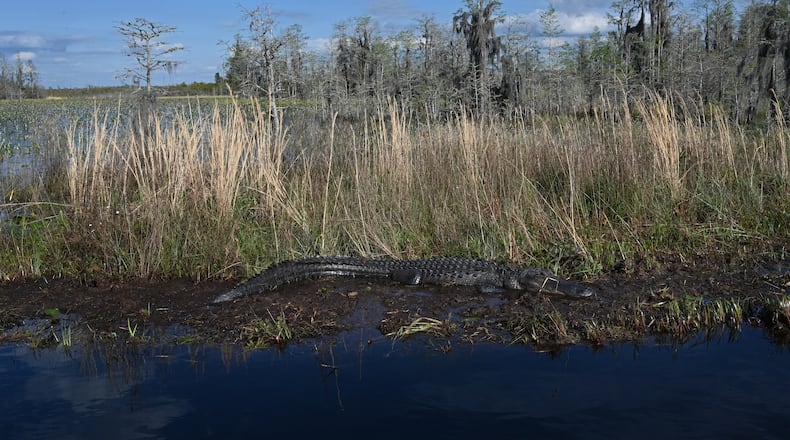After six years, a controversial bid to mine next door to Georgia’s famed Okefenokee Swamp is no more.
The Conservation Fund, a nonprofit specializing in acquiring at-risk lands, announced Friday it has purchased property near the Okefenokee where an Alabama-based company had planned to mine. The move puts an immediate halt to a project that scientists and environmentalists had feared could irreparably damage North America’s largest blackwater swamp.
It’s a stunning end to a yearslong fight over the mine that has been waged in courtrooms, the halls of the Georgia General Assembly and in rural counties surrounding the vast wilderness.
Credit: HYOSUB SHIN / AJC
Credit: HYOSUB SHIN / AJC
For environmental advocates who had pushed federal and state officials to reject the project, the agreement is likely to be seen as a monumental victory, even though other land along the swamp’s edge remains open to mining exploration.
The land is being purchased from Twin Pines Minerals — the company behind the proposed mine — for just under $60 million, according to The Conservation Fund.
The acquisition was brokered with the financial support of some of the country’s leading private philanthropies, including the James M. Cox Foundation and the Holdfast Collective, a nonprofit focused on environmental protection. Holdfast is funded by the outdoor apparel giant Patagonia. Jim Kennedy, the chairman of the James M. Cox Foundation, is chairman emeritus of Cox Enterprises, the parent company of The Atlanta Journal-Constitution.
In a statement, Kennedy called the Okefenokee “a Georgia and national treasure that must be protected.”
“It is extremely important that we work together to preserve natural habitats throughout our state and country,” he added.
The Conservation Fund is purchasing the nearly 600-acre tract Twin Pines had planned to mine initially, along with all of the company’s other land holdings in the area comprising roughly 8,000 acres. In addition to the land, the group is also acquiring the underlying mineral rights.
Twin Pines had promised its mine would protect the swamp and bring hundreds of good-paying jobs to rural Charlton County, home to the mine site and much of the Okefenokee. The median household income in Charlton County is about $26,000 less than it is statewide, according to the U.S. Census Bureau.
Twin Pines declined to comment on the sale of its land.
Drew Jones, a Charlton County commissioner who works for a large timber company, supported the project and decried the public backlash. He said the sale wastes an “opportunity for economic development in our poor, rural community” and scraps a chance for critical mineral sourcing.
“I strongly believe in private property rights and in the need for future projects to be assessed with greater objectivity, rather than driven by emotion or public pressure,” Jones said in a written statement.
Stacy Funderburke, The Conservation Fund’s regional vice president covering Georgia and Alabama, said that for now, the property will be managed for conservation. But ultimately, he said the organization’s goal is to permanently protect the land to allow public access, ideally by adding it to the federal Okefenokee National Wildlife Refuge.
Credit: HYOSUB SHIN / AJC
Credit: HYOSUB SHIN / AJC
Funderburke, who said he’s visited the swamp annually for almost 20 years, called the acquisition the most important deal he’s ever worked on.
“Even though we’ve worked on much larger acreage deals around the country and even larger dollar transactions, this one is the biggest so far,” Funderburke said.
Environmental groups who fought the mining proposal and helped rally funders praised the coalition for acquiring the land — and Twin Pines for choosing to sell the properties into conservation.
“Twin Pines’ decision to sell their land to a conservation buyer instead of to a mining company is a respectable response to the hundreds of thousands of voices who have spoken out against the mining proposal,” said Megan Desrosiers, president and CEO of the Brunswick-based coastal protection nonprofit One Hundred Miles.
Megan Huynh, a senior attorney with the Southern Environmental Law Center, praised Georgians who she said “sent a clear message to Twin Pines Minerals that mining next to the Okefenokee is an unacceptable risk.”
“This wouldn’t have been possible without a powerful coalition, and regular Georgians who were willing to stand up and defend a place as beloved as the Okefenokee,” Huynh said.
A fight over a natural wonder
Experts say the Okefenokee Swamp is an ecological gem with riches matched by few places on Earth.
Located in Southeast Georgia, the swamp contains the 407,000-acre national wildlife refuge, the largest preserve of its kind east of the Mississippi River. The federal government has nominated the refuge for a spot on the UNESCO World Heritage list. If selected, it would join world-renowned sites like the Great Barrier Reef and Machu Picchu.
The swamp is also home to hundreds of kinds of plants and animals, including threatened and endangered species like the red-cockaded woodpecker, indigo snake and wood stork. It forms the headwaters of two rivers: the Suwannee River, which empties into the Gulf of Mexico, and the St. Marys, which drains into the Atlantic Ocean. And it holds vast stores of carbon-rich peat — as deep as 15 feet in spots — keeping millions of tons of potent greenhouse gases out of the atmosphere.
Credit: HYOSUB SHIN / AJC
Credit: HYOSUB SHIN / AJC
But since 2019, Twin Pines had pressed forward with plans to mine nearby, despite stiff opposition from environmentalists, outdoorsmen, Georgia’s Democratic Senators Jon Ossoff and Raphael Warnock, and visitors to the swamp, enchanted by its unspoiled wilderness. In recent sessions at the General Assembly, the mine also survived legislative efforts to block it from expanding, at least temporarily.
Year after year, legislative proposals fizzled, failing to gain the support of key Republican leaders, despite bipartisan support.
The company’s plan had been to develop a nearly 600-acre “demonstration mine” on Trail Ridge, a line of mineral-rich sand dunes that run along the swamp’s eastern edge. But Twin Pines owned thousands more acres in the area and had made clear its intention to expand in the future, if its initial mine were approved.
The titanium sands Twin Pines was after would likely have been used primarily to produce titanium dioxide, a whitening pigment used in toothpaste, paint and other household products.
Credit: HYOSUB SHIN / AJC
Credit: HYOSUB SHIN / AJC
Until recent years, projects like Twin Pines’ would have required the federal government’s approval. But thanks to a sequence of regulatory decisions, Supreme Court rulings and legal settlements, permitting of the mine ended up solely in the hands of the Georgia Environmental Protection Division.
Scientists from the University of Georgia and the federal government had warned the mine’s planned groundwater withdrawals would diminish the swamp’s water budget. UGA hydrologist Rhett Jackson concluded that the mine would increase the frequency of drought in the swamp’s southeast quadrant, raising the odds of wildfires.
But the company insisted its plans were safe and would have no impact on the swamp.
It seemed EPD shared that view. In early 2024, the agency released draft permits for the project. And before the deal to buy the land was announced, the mine seemed poised to obtain final approval.
EPD declined to comment.
Jones, the Charlton commissioner, argued private forestland owners are being asked to bear the brunt of preserving their property rather than developing it.
“These lands provide tremendous public value, while also becoming increasingly unsustainable for private landowners to maintain them,” he said. “If the public values the many benefits it receives from privately owned forestland, then it must also recognize that these benefits come at a cost — one that has largely been borne, without compensation, by private landowners.”
Georgia House Speaker Jon Burns, whose chamber passed legislation in 2024 that could have temporarily impeded Twin Pines’ expansion plans, said in a written statement he was “grateful” that a deal was reached to acquire the land, “all while respecting private property rights and upholding our state’s longstanding commitment to our business community.”
Ossoff said in a statement that the step to protect the Okefenokee Swamp “is great news for all Georgians and our beloved natural treasure.”
New mining proposals could surface
With the mine off the table, environmental advocates are likely to turn their attention to supporting the Okefenokee’s World Heritage bid.
The refuge was nominated late in President Joe Biden’s administration with the bipartisan backing of Georgia’s congressional leadership. Earlier this year, former Georgia Gov. Sonny Perdue got behind the nomination, writing President Donald Trump’s Interior Secretary Doug Burgum to voice his support. Perdue served as Trump’s agriculture secretary during his first term and so far, Trump’s new administration has indicated it stands behind the bid.
The World Heritage Committee is expected to consider the nomination in 2026. Warnock said in a statement that Friday’s announced deal gives further credence to the World Heritage bid, which “would support both the economy and the ecology.”
Credit: HYOSUB SHIN / AJC
Credit: HYOSUB SHIN / AJC
Even with Twin Pines’ pursuit over, it’s possible new proposals to mine near the swamp could surface.
Decades before Twin Pines revealed its plans, the mineral and materials giant DuPont also tried to mine thousands of acres on Trail Ridge in the late 1990s. Under pressure from environmentalists and then-Secretary of the Interior Bruce Babbitt, the company abandoned its project.
In heading off that proposal, The Conservation Fund also played a major role. DuPont donated the land it planned to mine to The Conservation Fund and a portion is now part of the Okefenokee National Wildlife Refuge.
Today, large chunks of Trail Ridge remain privately held, including by property owners who have expressed interest in exploring mining on their land.
Funderburke of The Conservation Fund acknowledged there’s a “huge need” for more land to be protected and said his organization will continue discussions to benefit the swamp and protect property rights.
“We have been laser-focused on Twin Pines for the last year, but we are very open to finding other conservation outcomes to ensure that the Okefenokee is protected forever,” he said.
Josh Marks, president of Georgians for the Okefenokee and a veteran of the resistance to the DuPont and Twin Pines’ mines, cheered the deal, but said it’s critical not to lose sight of the need to protect other land at the swamp’s edge from mining. He also called on the General Assembly to pass legislation called the Okefenokee Protection Act, which would block permitting of new mines on Trail Ridge.
Marks called the mine purchase a “huge victory” for Georgians who have long fought to protect the Okefenokee. “But the threat is not over by a long shot,” he said.
- Staff writers Greg Bluestein and Zach Hansen contributed to this story.
A note of disclosure
This coverage is supported by a partnership with Green South Foundation and Journalism Funding Partners. You can learn more and support our climate reporting by donating at AJC.com/donate/climate.
About the Author
Keep Reading
The Latest
Featured







